Sparrows
Most people, at the mention of sparrows, think first of the House Sparrow. That bird is familiar enough�it thrives in urbanized areas, including southwestern cities�but it belongs to a family that is native to the Old World. The sparrows that occur naturally on this continent are a much more diverse group, many with distinctive patterns and musical songs. All of them have short thick bills�designed for cracking open seeds, a major part of their winter diets� but all eat many insects as well, especially in warm weather.
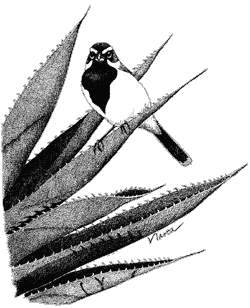 |
The ultimate dryland sparrow is the Black-throated Sparrow, a smartly patterned bird that thrives year-round in the Sonoran Desert and also in the much sparser plant growth of the Chihuahuan Desert farther east. However, several other species are permanent residents around the edges of this habitat. Song Sparrows (of a distinctive local form, paler and redder than Song Sparrows elsewhere) are common along desert rivers where there is still healthy riparian growth. Rufous-winged Sparrows survive in desert patches that have escaped the effects of overgrazing, while Rufous-crowned Sparrows haunt rocky canyons and foothills. The towhees, big sparrows that forage by scratching actively on the ground, are represented by Abert�s Towhees along lowland rivers and Canyon Towhees on drier slopes.
Winter is the season when sparrow diversity peaks, as more species move in from the north. Flocks of White-crowned Sparrows range along the brushy arroyos, flocks of Brewer�s Sparrows are common on the more open flats, and several other species appear as well. Because they feed largely on seeds at this season, their numbers vary: if the summer and fall rains have produced a good crop of annual weed and grass seeds, the winter desert may be alive with sparrows.
�Kenn KaufmanSparrows
Representative Sonoran Desert species:
Rufous-winged Sparrow (Aimophila carpalis)
Rufous-crowned Sparrow (Aimophila ruficeps)
Brewer�s Sparrow (Spizella breweri)
Black-throated Sparrow (Amphispiza bilineata)
Sage Sparrow (Amphispiza belli)
Song Sparrow (Melospiza melodia)
Lincoln�s Sparrow (Melospiza lincolnii)
White-crowned Sparrow (Zonotrichia leucophrys)
Order: Passeriformes
Family: Emberizidae (Buntings and their relatives)
Spanish names: gorri�n, zacatero
Distinguishing Features
Rufous-winged Sparrow: Pale gray below, brown above with small rusty spot on shoulder; gray face with rusty stripes on crown and behind eye, 2 short black whisker stripes below bill.
Rufous-crowned Sparrow: Gray-brown above, gray below, with rusty crown and single heavy black whisker stripe below bill.
Brewer�s Sparrow: Very plain, small, and relatively long-tailed; sandy-brown above with narrow black streaks on back and crown, brown ear patch, plain pale gray below.
Black-throated Sparrow: Black throat and mask; white eyebrow and malar (chin) streak; gray crown, back, and wings; white belly; dark bill.
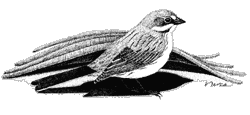 |
Sage Sparrow: White spot above the bill; white throat with black whisker; gray crown, back and wings; white on outer tail feathers; dark bill.
Song Sparrow: Brown streak extending behind eye, thick white streak below bill, brown wings with some rust, underparts white with heavy dark streaks and central breast spot.
Lincoln�s Sparrow: Brown crown with central gray stripe, gray face and eyebrow, buffy breast and flanks with fine streaks, white belly.
White-crowned Sparrow: Black and white head stripes, gray face and underparts, tan back with dark streaks, pink bill.
Habitat
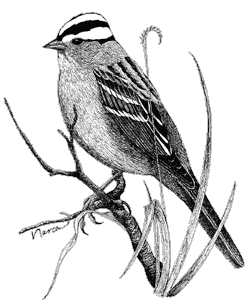 |
Rufous-winged Sparrow: Desert grass mixed with brushes, mesquite, cholla. Rufous-crowned Sparrow: Grass or bushy vegetation, often near rocky slopes or outcrops. Brewer�s Sparrow: Open desert, especially creosote flats (winter). Black-throated Sparrow: Found mainly in desert thornscrub and dry, open habitats such as creosote and sagebrush flats. Sage Sparrow: Deserts and open brushy flats (winter). Song Sparrow: Inhabits mainly streamside and low, dense brushy areas in the Sonoran Desert region. Lincoln�s Sparrow: Areas with dense vege-tation and overgrown fields (winter). White-crowned Sparrow: Desert washes, ranches, gardens, parks, and along streams.
Feeding
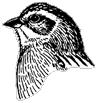 |
 |
 |
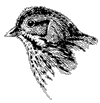 |
� Diet: Sparrows in the Sonoran Desert region feed mostly on insects and seeds.
� Behavior: Rufous-winged Sparrow forages mainly by hopping around on the ground, occasionally taking insects midair; feeding takes place in pairs or in family groups.
Rufous-crowned Sparrow forages by walking or hopping slowly on the ground or in low bushes; usually found foraging in pairs or in family groups.
Brewer�s Sparrow forages on the ground or in low vegetation usually in flocks.
Black-throated Sparrow forages by moving around on the ground or in desert trees and other vegetation; occasionally catches insects midair.
Sage Sparrow forages mainly on the ground where it is sometimes seen scratching the soil to turn up food items; forages in flocks when not nesting.
Song Sparrow forages mainly on the ground but also feeds in trees and shrubs; will come to feeders if they are in good cover.
Lincoln�s Sparrow forages by hopping on the ground near or under denser vegetation.
White-crowned Sparrow forages mainly by hopping or running around on the ground, occasionally taking insects midair; forages in flocks when not nesting.
Life History
Because of their generally brownish and often nondescript coloring, identifying sparrows can be a difficult and often unrewarding exercise for the beginning birder. But with a little persistence the birder can learn to recognize these species by their intricate markings and often engaging songs.
All of the sparrows mentioned here live near the ground or very close to it. The majority nest as isolated pairs and aggressively defend their nesting areas by driving away intruders of their own species.
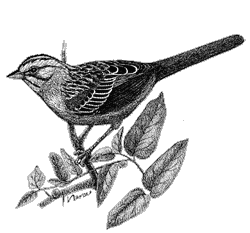 |
The females of most of the species mentioned here are responsible for nest building. Cup-shaped nests made of twigs and weeds are located in dense low-growing brush or cacti, or on the ground. A range of from 2 to 5 eggs, which may be plain or spotted, are most often incubated by the female only; usually both parents share in feeding the young. Rufous-winged and rufous-crowned young leave the nest 8 to 9 days after hatching; the other species leave typically between 9 and 12 days after hatching.
Towhees
Representative Sonoran Desert species:
Canyon Towhee (Pipilo fuscus)
Abert�s Towhee (Pipilo aberti)
Green-tailed Towhee (Pipilo chlorurus)
Order: Passeriformes
Family: Emberizidae
Spanish names: vieja, viejita, ilama, toqui de Abert (Abert�s Towhee),
toqui cola verde (Green-tailed Towhee)
Distinguishing Features
Canyon Towhee: This is a large sparrow-like bird, about 8¼ inches (21.6 cm) long. Both sexes are similar in appearance, with rusty undertail coverts and a touch of rust on the crown. It is usually found in pairs in southern Arizona and adjacent Sonora, but is not always easily seen. Abert�s Towhee: A large (9 inches in length; 23 cm), fluffy, buff-brown bird with black feathers edging the bill. Both sexes look alike. It can be distinguished from the brown towhee by its richer brown color and black on the face. Green-tailed Towhee: About 6¼ to 7 inches (16.5 to 18 cm) in length, this bird has a plain olive-green back, rufous crown, a conspicuous white throat, and a gray breast. The rufous crown and the white throat are the best identifying marks. The tail is relatively long and prominent. The bill is black.
Habitat
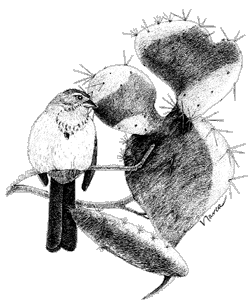 |
Canyon Towhee: A characteristic Sonoran desert bird; a common resident ground-dwelling bird, it prefers scrubby desert areas, foothills and canyons.
Abert�s Towhee: Common in southern Arizona where it is restricted to thickets near water; it frequents thickets or mesquite bosques along streams or irrigation canals in low desert areas.
Green-tailed Towhee: Prefers arid, brushy foothills and mountain slopes, the more open pine forests, and chaparral.
Feeding
� Diet and Behavior: All 3 species feed on seeds and insects found on or near the ground.
Life History
The Canyon Towhee weaves a cup-shaped nest of plant leaves and fibers, usually 6 to 15 feet high in a shrub or tree (sometimes in mistletoe clumps). The female incubates the 3 or 4 bluish-green eggs for about 11 days. The young fledge in 8 to 9 days. If the nest is approached, the female, like other towhees, drops straight to the ground and runs away in mouselike fashion, probably as a distraction.
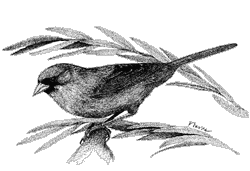 |
Abert�s Towhee lays 3 to 4 eggs in a bulky cup-shaped nest woven of plant fibers and placed low in a tree or shrub. It is a common cowbird host; its future is threatened by cowbird impact and disappearance of desert riparian habitat.
Green-tailed Towhee builds a deep, cupped nest of twigs, grasses, and stems and lines it with small roots and hair. It is built near the ground in dense foliage. Usually 4 spotted eggs are laid.
Dark-eyed Junco (Junco hyemalis)
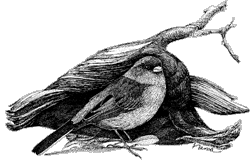 |
Order: Passeriformes
Family: Emberizidae
Distinguishing Features
This bird is 5 to 6½ inches (13 to 16 cm) in length, with considerable geographic variation in plumage: all have white outer tail feathers, dark hood, and pale belly, but back and sides vary from gray to reddish-brown.
Habitat
The Dark-eyed Junco inhabits the edges of woodlands or conifer forests throughout its range. In the Sonoran Desert this species occurs only in winter where it inhabits semi-open areas including roadsides, brushy spots, parks, and suburban gardens.
Feeding
� Diet: Mostly seeds and insects but also eats small berries.
� Behavior: Forages mainly by running or hopping on the ground. Tends to feed on spilled seed under bird feeders. Also seen moving through the branches of trees or shrubs.
Life History
During nesting season the male sings from a high perch to defend his territory. Both birds may droop their wings and spread their tail feathers during courtship displays. The nest is usually on the ground in a well-hidden and protected spot, although it can also be located in shrubs, trees, or building overhangs. The female makes a cup-shaped nest out of grass, weeds, leaves, and twigs and lines it with finer material such as hair and grass. The 3 to 6 bluish-white eggs have blotches concentrated on the large end. Incubation by the female takes 11 to 13 days. Both parent birds feed the nestlings. The young leave the nest 9 to 13 days after hatching.
This species is migratory, although some birds in the mountains of southwestern United States are permanent residents.